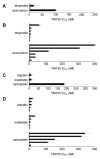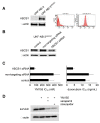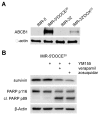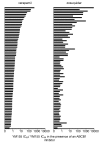Testing of the Survivin Suppressant YM155 in a Large Panel of Drug-Resistant Neuroblastoma Cell Lines
- PMID: 32131402
- PMCID: PMC7139505
- DOI: 10.3390/cancers12030577
Testing of the Survivin Suppressant YM155 in a Large Panel of Drug-Resistant Neuroblastoma Cell Lines
Abstract
The survivin suppressant YM155 is a drug candidate for neuroblastoma. Here, we tested YM155 in 101 neuroblastoma cell lines (19 parental cell lines, 82 drug-adapted sublines). Seventy seven (77) cell lines displayed YM155 IC50s in the range of clinical YM155 concentrations. ABCB1 was an important determinant of YM155 resistance. The activity of the ABCB1 inhibitor zosuquidar ranged from being similar to that of the structurally different ABCB1 inhibitor verapamil to being 65-fold higher. ABCB1 sequence variations may be responsible for this, suggesting that the design of variant-specific ABCB1 inhibitors may be possible. Further, we showed that ABCC1 confers YM155 resistance. Previously, p53 depletion had resulted in decreased YM155 sensitivity. However, TP53-mutant cells were not generally less sensitive to YM155 than TP53 wild-type cells in this study. Finally, YM155 cross-resistance profiles differed between cells adapted to drugs as similar as cisplatin and carboplatin. In conclusion, the large cell line panel was necessary to reveal an unanticipated complexity of the YM155 response in neuroblastoma cell lines with acquired drug resistance. Novel findings include that ABCC1 mediates YM155 resistance and that YM155 cross-resistance profiles differ between cell lines adapted to drugs as similar as cisplatin and carboplatin.
Keywords: ABCB1; ABCC1; YM155; drug resistance; neuroblastoma; survivin.
Conflict of interest statement
The authors declare no conflict of interest. The funders had no role in the design of the study; in the collection, analyses, or interpretation of data; in the writing of the manuscript, or in the decision to publish the results.
Figures









Similar articles
-
Effects of YM155 on survivin levels and viability in neuroblastoma cells with acquired drug resistance.Cell Death Dis. 2016 Oct 13;7(10):e2410. doi: 10.1038/cddis.2016.257. Cell Death Dis. 2016. PMID: 27735941 Free PMC article.
-
YM155-Adapted Cancer Cell Lines Reveal Drug-Induced Heterogeneity and Enable the Identification of Biomarker Candidates for the Acquired Resistance Setting.Cancers (Basel). 2020 Apr 26;12(5):1080. doi: 10.3390/cancers12051080. Cancers (Basel). 2020. PMID: 32357518 Free PMC article.
-
Targeted BIRC5 silencing using YM155 causes cell death in neuroblastoma cells with low ABCB1 expression.Eur J Cancer. 2012 Mar;48(5):763-71. doi: 10.1016/j.ejca.2011.10.012. Epub 2011 Nov 14. Eur J Cancer. 2012. PMID: 22088485
-
Testing of SNS-032 in a Panel of Human Neuroblastoma Cell Lines with Acquired Resistance to a Broad Range of Drugs.Transl Oncol. 2013 Dec 1;6(6):685-96. doi: 10.1593/tlo.13544. eCollection 2013 Dec 1. Transl Oncol. 2013. PMID: 24466371 Free PMC article.
-
Adaptation to chronic exposure to sepantronium bromide (YM155), a prototypical survivin suppressant is due to persistent DNA damage-response in breast cancer cells.Oncotarget. 2018 Sep 11;9(71):33589-33600. doi: 10.18632/oncotarget.26096. eCollection 2018 Sep 11. Oncotarget. 2018. PMID: 30323901 Free PMC article.
Cited by
-
17q Gain in Neuroblastoma: A Review of Clinical and Biological Implications.Cancers (Basel). 2024 Jan 12;16(2):338. doi: 10.3390/cancers16020338. Cancers (Basel). 2024. PMID: 38254827 Free PMC article. Review.
-
Targeting the apoptosis pathway to treat tumours of the paediatric nervous system.Cell Death Dis. 2022 May 14;13(5):460. doi: 10.1038/s41419-022-04900-y. Cell Death Dis. 2022. PMID: 35568716 Free PMC article. Review.
-
From DNA Copy Number Gains and Tumor Dependencies to Novel Therapeutic Targets for High-Risk Neuroblastoma.J Pers Med. 2021 Dec 3;11(12):1286. doi: 10.3390/jpm11121286. J Pers Med. 2021. PMID: 34945759 Free PMC article. Review.
References
Grants and funding
LinkOut - more resources
Full Text Sources
Medical
Research Materials
Miscellaneous

